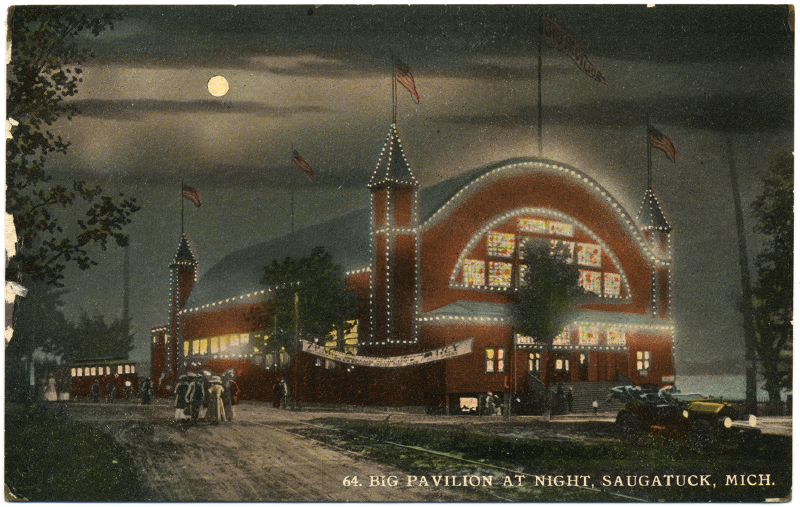 SOCIAL DANCING was once a popular form of recreation in Michigan. From the late 1880s, dance pavilions sprung up across the state, many of them built on waterfronts. City people, accustomed to entertainment options in the big cities, sought evening recreation — and dancing fit the bill.
SOCIAL DANCING was once a popular form of recreation in Michigan. From the late 1880s, dance pavilions sprung up across the state, many of them built on waterfronts. City people, accustomed to entertainment options in the big cities, sought evening recreation — and dancing fit the bill.
From the stately waltzes of earlier years, the 1910s gave way to dances like the grizzly bear, bunny hop and turkey trot. The Roaring ’20s brought the fox trot, tango, jitterbug, Lindy hop and Charleston.
“Brightest Spot on the Great Lakes” because of its 5,000 exterior light bulbs that could be seen by boats on Lake Michigan. The colored interior lights flickered to the timing of the music while dancers swirled on the 6,000-square-foot dance floor.
During the Depression, dancing continued to flourish as an inexpensive form of recreation. The 1930s also saw the dance marathon craze — contests of endurance and sometimes desperation for prize money. The rise of swing and Big Band music in the 1930s and ’40s drew thousands to dance halls. Rock ’n’ roll in the 1950s brought the hand jive and the twist.
Some of Michigan’s dance pavilions, or casinos, as they were sometimes called, were part of an amusement park. Others were operated by streetcar lines, resorts or hotels, yacht or country clubs, or other social organizations.

Many pavilions had decks and open windows so cool breezes off the water could cool the dancers. Refreshments might include ice cream, popcorn and lemonade or soda. During Prohibition (1920-1933), dancers sometimes concealed liquor flasks in their clothing. Dance pavilions usually had house bands, often a 10-piece orchestra. Some dance halls brought in national acts like Glenn Miller and Tommy Dorsey.
The Big Pavilion in Saugatuck, built in 1909 on the Kalamazoo River, was known as the “Brightest Spot on the Great Lakes” because of its 5,000 exterior light bulbs that could be seen by boats on Lake Michigan. The colored interior lights flickered to the timing of the music while dancers swirled on the 6,000-square-foot dance floor. The same businessmen who built the Saugatuck pavilion built a similar building in South Haven: the Avery Beach Casino, also known as the Big Casino.
Other lakeshore dance pavilions built by private enterprises included Rainbow Gardens in Ludington and the Crystal Palace at Paw Paw Lake.
 One popular park featuring dancing was Silver Beach on Lake Michigan in St. Joseph. The Shadowland Dance Pavilion was built in 1927, decorated with 5,000 yards of draped Chinese silk. Dances were held every night during the summer season, when as many as a thousand dancers took to the floor.
One popular park featuring dancing was Silver Beach on Lake Michigan in St. Joseph. The Shadowland Dance Pavilion was built in 1927, decorated with 5,000 yards of draped Chinese silk. Dances were held every night during the summer season, when as many as a thousand dancers took to the floor.
Amusement parks with dance pavilions included Ramona Park on Reeds Lake in East Grand Rapids, Lake Michigan Park in Muskegon, Waverly Park in Lansing and Wenona Beach Park in Bay City. Some of these were built by local streetcar or interurban railroad lines.
In 1902, the Fruitport Pavilion, on Spring Lake at the shores of Pomona Park, was built by the Grand Rapids, Grand Haven and Muskegon Railroad Co., which operated it until 1928 when it was sold to a local band leader and music promoter.
Johnson’s Rustic Resort on Houghton Lake was one of the few resorts to operate its own dance hall. Its pavilion opened in 1926, and drew crowds from a 40-mile radius. For six nights a week during the summer, hundreds of dancers moved to the tunes of syncopated rhythm.
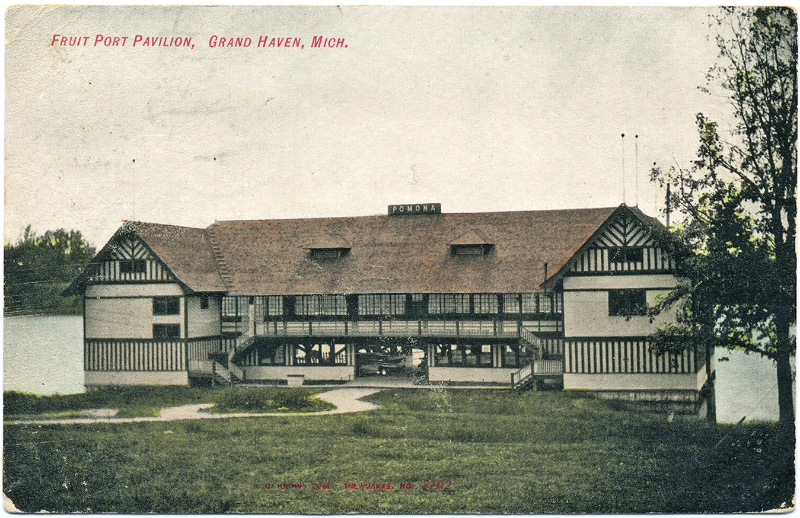
The popularity of the jukebox led to the demise of many of the dance pavilions. Some of them turned to roller skating, movies or bingo to keep their doors open, or adapted to uses as community centers or playhouses.
Many of the pavilions live on in the memories of those who danced with their sweetheart on Michigan summer nights to the sounds of a jazz quartet or a Big Band. That must have really been something.
BLUE Vintage Views columnists M. Christine Byron and Thomas R. Wilson reside in Grand Rapids. They are authors of the book, “Vintage Views Along Scenic M-22 including Sleeping Bear Dunes.”



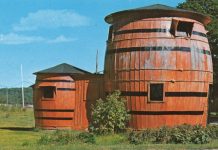
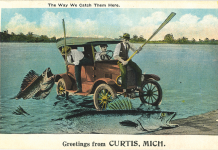
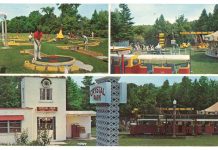

Facebook Comments